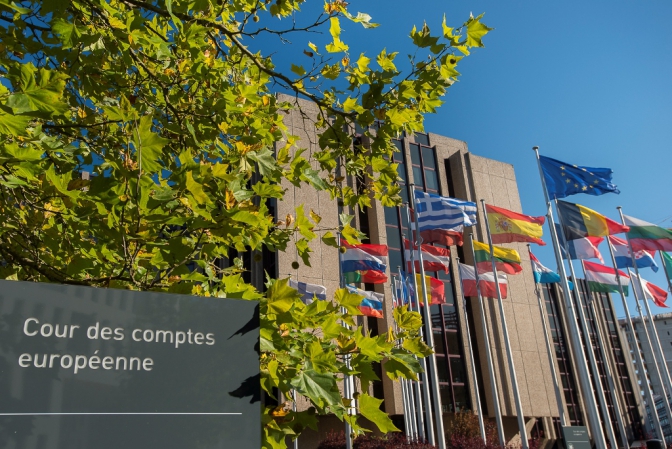The piecemeal approach taken to set up the EU’s financial landscape in the last 15 years has resulted in a patchwork construction that is overly complex and not fully publicly accountable, according to a special audit report published on Wednesday by the European Court of Auditors (ECA).
“The EU’s current financial landscape has been described by the European Parliament as a galaxy of funds and instruments surrounding the EU budget,” said François-Roger Cazala, the French ECA member who led the audit, at a virtual press briefing (1 March). He referred to figure 3 in the report which indeed depicts the EU budget as a galax surrounded by off-budget and hybrid instruments.
“While there have been legal and political reasons for their creation, we believe that further simplification and accountability are necessary to improve efficiency and transparency,” he said.
He referred to economic and other crises in the EU and the member states, in particular the Covid-19 pandemic which required new instruments for weathering the pandemic (SURE) and the recovery and resilience facility (RRF or NextGenerationEU).
The total amount of these instruments is not calculated in the report but a list of them in an annex to the report shows that they amount to hundreds of billions of euros.
Even if there was a formal justification for their creation, many instruments lacked appropriate prior evaluations and the selected design (including their off-budget nature) was not supported by impact assessments or similar pre-evaluations in most cases. This does not imply a violation of EU rules, the ECA member told The Brussels Times, but could be seen as a circumvention of the rules.
According to the auditors, this also makes it impossible to demonstrate that the creation of an off-budget instrument was better than using the EU budget, and that the proposed instrument was the most efficient one. The instruments are also often outside the audit of ECA or the scrutiny of the European Parliament.
Public scrutiny and accountability are important but even a consolidated and complete set of information on all instruments is missing. Although the European Commission’s recently introduced Budgetary Transparency Report is seen as a positive step, it does not cover all instruments.
The vast majority of the EU budget is used to finance spending programmes that are funded under the EU’s budget planning (the so-called multiannual financial framework or MFF). The ECA has full rights to audit everything under the EU budget but usually not the off-budget instruments, unless explicitly stated.
For that reason, ECA cannot say if the error rate in these instruments differ from the regular EU budget which it audits annually.
However, ECA has the right to audit the most significant instruments or "stars in the galaxy" such as SURE and RRF that were established during the COVID-19 pandemic. In a audit in December last year, ECA concluded that the EU support to mitigate unemployment risks in an emergency (SURE) was a prompt response during the COVID-19 pandemic but its impact in the EU member states is not sufficiently known.
Furthermore, ECA will publish an audit on Wednesday (8 March) on the Recovery and Resilience Facility (RRF). The report ("Do checks on the €724 billion Recovery and Resilience Facility ensure that EU financial interests are safeguarded") will be presented by ECA President Tony Murphy.
While ECA lacks the right to audit some of the off-budget instruments, they are in most cases audited by the supreme audit institutions (SAIs) in the member states. ECA can be invited to these audits but it cannot be as proactive as it would like.
“It’s a rather theoretical question,” ECA member Cazala explained. “We are cautious and won’t force it. The SAIs are doing their job according to their audit work programmes. There are no procedures for consulting us or carrying out joint audits of the off-budget instruments.”
His final message is that the issue is both technical and political but that there is room for simplifications and a better analysis of the instruments.
A Commission spokesperson took note of the report as soon as it was published and welcomed the fact that ECA has acknowledged that “there are legitimate reasons and historical developments that caused the current EU financial architecture”.
However, the Commission does not concur with the ECA’s assessment of a ‘patchwork construction’. According to the Commission, “all existing instruments were adopted in full respect of the relevant legal bases, specific policy objectives and positions of the Member States, as well as according to the relevant interinstitutional and decision-making procedures”.
As regards the audit recommendations, the Commission accepted or partially accepted them to the extent that they are under the Commission’s control, taking into account that they cannot infringe on the Commission’s right of legislative initiative and that they need to respect the rules and procedures laid down in the treaties.
It did not accept the recommendation to integrate the Modernisation Fund in the EU budget “since it would pre-empt the design of the post-2027 MFF”. The fund supports 10 Member States to meet 2030 energy targets by helping them to modernise their energy systems and improve energy efficiency. It is estimated that around €51 billion of support will be provided, depending on the carbon price.
M. Apelblat
The Brussels Times

